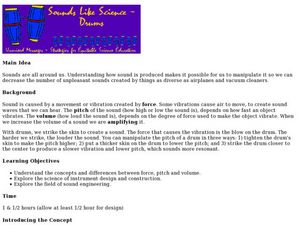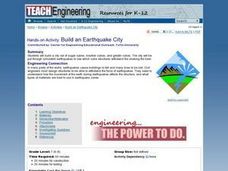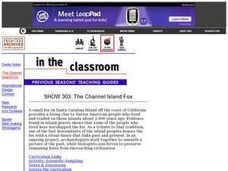Curated OER
Paper Gliders
Sixth graders study friction and drag. In this science instructional activity, 6th graders use different models of gliders and test to see which of the gliders fly the farthest. Students analyze their data and construct a graph.
Curated OER
Simple Harmonic Motion
Students study harmonic motion and its oscillation. In this simple harmonic motion lesson students demonstrate a series of regular oscillations and explain the theory behind the experiment.
Curated OER
Sounds Like Science - Drums
Young scholars see that understanding how sound is produced makes it possible for us to manipulate it so we can decrease the number of unpleasant sounds we encounter. They make a drum to explore the concepts of force, pitch and volume.
Curated OER
Sounds Like Science: Drums
Students explore the science of sound. In this sound lesson, students craft drums from various materials and respond to questions regarding pitch, force, and volume.
Curated OER
Wind Power for Educators
Students explore wind power as a renewable resource. In this wind power lesson students build models of wind turbines and experiment with different changes to see if it increases efficiency.
Curated OER
Simple Harmonic Motion
Students explore the theory of simple harmonic motion (SHM) by performing hands-on, practical application experiments. In this harmonic motion lesson, students use strings of various lengths and bobs of different weights to create a...
Curated OER
Plants 1: Plant Parents
Students review their prior knowledge on plants. In groups, they compare and contrast the difference between reproducing asexually and sexually. Using the internet, they research how some plants can be forced to produce asexually.
Curated OER
Build An Earthquake City
Students work together to build an earthquake city. They simulate the shaking during an earthquake to discover if their structure is built well enough. They discover how engineers complete these types of tests to develop better...
Curated OER
Observing Objects
Students observe the motion of both a pendulum and a spring pendulum . They then explain the differences and the similarities between the two types of motions.
Curated OER
Tightrope Trials
Students research the concepts of center of mass and how to make different things balance. They make symmetrical cut-outs of different "creatures" and experiment with how they balance on a tightrope of string.
Curated OER
The Power of Atmospheric Pressure Process
Middle schoolers are introduced to the basic principles of atmospheric pressure. After watching demonstrations, they discover the capability of air pressure and how it affects weather. In groups, they use an inquiry template to solve...
Curated OER
Mud Splat Craters
Learners simulate crater formation using mud. In this earth science lesson, students identify the features of a crater. They explain how the force of impact affect the crater's appearance.
Curated OER
Soil Formation
Seventh graders investigate how soil is formed. They analyze types of soil samples, examine soil using a magnifying glass or microscope, complete a chart, conduct a soil and plant experiment, and construct a soil profile.
Curated OER
Erosion: On the Move...Defending the Coast Against Wave Attack
Students study how people have tried to save beaches from wave erosion. They examine what has occurred to Cape Hatteras as a result of beach erosion and the efforts to reduce the erosion.
Curated OER
Swing and Sway
Students research the destructive force of the wind. In this science lesson, students design and build a wind resistant structure. They explain why they chose a particular design and present their structure in class.
Curated OER
Teaching the Tr'panier Trapezoid Kite
Students analyze how the parts of a system go together and how these parts depend on each other. They comprehend the forces in terms of strength and direction. Students observe, measure and describe weather indicators.
Curated OER
Flight Home Lesson Plan 3
Students examine photographs of twentieth-century aircraft from the National Air and Space Museum. They compare aircraft wings, fuselages, and engines to investigate different approaches to aircraft design.
Curated OER
SHOW 303: The Channel Island Fox
Pupils explore how archaeologists and other scientists use different clues to piece together a picture of the past. Students perform activities that allow them to conduct three types of scientific research. They discuss their...
Curated OER
Simple Machines
Students demonstrate an understanding of how simple machines work. They show how various forces affect movement and advantages of them. They also design a compund machine. Students decide which level of questions they want to do and...
Curated OER
Pumps
Students examine the basic types of pumps. They build a gravity-driven water pump and solve a mystery using their knowledge of pressures and pumps.
Curated OER
How Do Things Fall?
Students observe falling objects. They discover the rate of falling is based on air resistance and not the weight of the objects. They discuss how engineers use this type of information to design aerodynamic shapes.
Curated OER
Teaching The Scientific Method Using Adhesives
Learners use the six step scientific method to experiment with the differences in adhesives. Students test for tack, shear, and peel in these activities.
Curated OER
Weathering and Erosion
Sixth graders discuss the differences between chemical and mechanical weathering. Using that information, they create a concept map showing the forces that cause these types of weathering. After participating in an activity, they...
Science Matters
Fault Formations
The San Andreas Fault moves about two inches a year, approximately the same rate fingernails grow—crazy! The third lesson in the series allows for hands-on exploration of various fault formations. Through the use of a Popsicle stick,...

























